
It started in October 2010. I had just moved to Atlanta and didn’t know a thing about the city.
I picked a neighborhood at random – eeny-meeny-miney-moe – and rented the first listing on Craigslist. I struck gold.
I moved two blocks from Atlanta’s most beautiful park, a rolling greenscape with spectacular skyline views. It hosts huge outdoor concerts, festivals and farmer’s markets, and it’s less than a 5 minute walk from our front door.
I immediately thought: This neighborhood rocks. There’s strong rental demand from young professionals with great credit. So I started looking at real estate prices.
OUCH! They were astronomical. We’re talking $650,000 for a 2,000 sq.-ft. home. Yeech.
But I don’t give up. I get creative.
Multi-unit buildings – houses that have been subdivided into two or more rental units – are cheaper. People buy their own home based on emotion: it represents their dream home. But people buy multi-units on cold calculation: does the rent justify the price?
As a result, duplex and triplex buildings in our area are much cheaper than single-family homes.
I checked the price of the 3-unit building in which I rented. The landlord purchased the building in 2004 for $323,000. His monthly gross rental income is approximately $2,400.
Assuming our landlord put 20 percent down and has a 5 percent interest rate, his monthly mortgage would be $1,725 per month. Our landlord’s water bill – he outright told me – is $300 per month (last month he paid $320). Trash is $100 a month ($33 per month per unit). Insurance comes to $250 a month. In other words: his baseline expenses are $2,375 and his income is $2,400.
That leaves tiny room for error. If the water bill spikes an extra $25, the landlord has to cover the difference out-of-pocket. And he has NOTHING set aside for management or maintenance. In other words, his investment is “negative cash flow” – it removes money from his pocket every month.
He holds this because he hopes (he speculates, he gambles) the building will rise in value.
BAD IDEA!!!!!!!
No matter how nice the neighborhood is, I’m dead-set against buying a negative cash flow property, for two reasons:
1) It’s a gamble. Housing prices can rise OR fall.
2) The “cap rate” (a measure of return-on-investment) is nonexistent on a negative-cash-flow property. And I’m into making math-based decisions.
3) There’s a limit to how many negative-flow properties you can afford. There’s no limit to how many “positive cash flow” properties you can afford – property that lines your pocket with cash every month. (If your properties put cash in your pocket each month, then the more you buy, the more you can keep buying. The rich get richer.)
(Note: Don’t get angry that the rich get richer. Put yourself that same position.)
So I started searching for properties. But our neighborhood isn’t “up-and-coming.” As I like to say – with a fake Southern accent – “It done up-and-came.” Despite the housing crash, home prices are still astronomically higher than the rents they fetch.
I searched high and low. Nothing in that neighborhood could create positive cash flow and a solid cap rate. I almost gave up.
And then I discovered the house nobody wants.
Check out Part 2 of this real estate series to learn why the house is so cheap (what’s the catch?) and to discover how I cobbled together the funds to make the deal sail through.